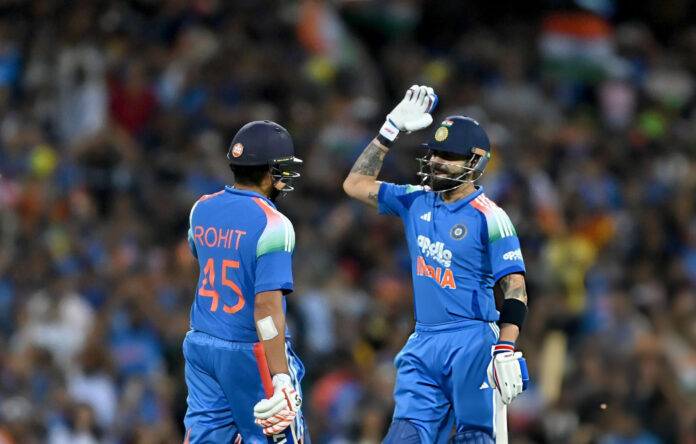At the Sydney Cricket Ground (SCG) on 25 October 2025, the Indian men’s cricket team secured a decisive victory in the third One-Day International (ODI) against Australia, underlining a return to form for two of its most prominent batters, Rohit Sharma and Virat Kohli. Australia, having won the toss and elected to bat first, posted a total near 236 runs. India responded with a composed chase and completed the run-chase with plenty of overs to spare, losing just one wicket. Rohit hammered his 33rd ODI century, anchoring the Indian innings from the front. His knock provided the backbone of the chase and highlighted his ability to bounce back after a quiet start to the series. His timing shot selection and ability to rotate strike while still punishing loose deliveries were key features of his performance. Virat Kohli responded to earlier disappointments in the series with a much-needed half-century. He reached his 75th ODI fifty, and by doing so climbed the all-time ODI run-scorers list to second place (behind only Sachin Tendulkar). His innings demonstrated patience and refinement: fewer risks, more placement and timing, and a strong partnership with Rohit.
The partnership that sealed the game
Once Shubman Gill departed early, it was the veteran duo of Rohit and Kohli who steadied the ship and then accelerated. They constructed a partnership of over 100 runs which took India from 100/1 to a dominant position. Their approach balanced caution and aggression—first building, then punishing—allowing India to underline their superiority in this match. Australia’s batting lineup did not offer enough resistance, as India’s bowlers chipped away at the target effectively. Once India got set, the chase looked increasingly routine. On the bowling side, some key overs leaked too many runs, and the visitors exploited that. The win gives India a strong finish to the series, reinforcing their depth and experience in the 50-over format. For Rohit and Kohli, the innings mark a reaffirmation of their value at the top of the order—especially important as Indian cricket navigates transitions with younger players coming in. Australia will reflect on failing to defend a modest total and allowing India’s top order to dominate. From a strategic perspective, India’s chase illustrates the effectiveness of veteran leadership in major run-chases: staying patient, building partnerships, then accelerating. India’s win in the third ODI against Australia demonstrated the impact of composed batting, strong partnerships and experienced leadership. Rohit Sharma’s century and Virat Kohli’s resurgence provided the foundation for the victory. With the series wrapped up, India leave Australia with a statement win.
Australia’s bright beginning under the afternoon sun faded into frustration as India’s spinners orchestrated a sharp turnaround, restricting the visitors to 236 all out in their allotted 50 overs. After winning the toss and opting to bat, Australia looked poised for a formidable total, but a disciplined Indian bowling effort, led by Harshit Rana’s four-wicket burst and Washington Sundar’s controlled spell, turned the tide decisively in India’s favour. The Australian openers, Mitchell Marsh and Travis Head, capitalized on a flat pitch and loose new-ball bowling from India’s pacers. The duo raced through the Powerplay, smashing boundaries with authority and punishing every inch of width. By the end of the first six overs, the scoreboard read 61 for no loss, and the visitors seemed well on course for a commanding total. Marsh, in particular, looked in ominous touch, pulling and driving with ease, while Head provided steady support from the other end. However, the narrative shifted once spin entered the frame. As soon as Washington Sundar and Kuldeep Yadav took charge, the momentum stalled. The variation in pace, flight, and angle exposed Australia’s middle order. Sundar’s ability to extract subtle turn and maintain a miserly line frustrated the batters, while Kuldeep’s sharp googlies and Axar Patel’s accuracy created constant pressure. What was once an aggressive Australian charge turned into a cautious crawl.
India’s spinners choked the scoring opportunities, conceding just 82 runs between overs 11 and 30, while picking up crucial wickets. The top five Australian batters — Marsh, Head, Marnus Labuschagne, Glenn Maxwell, and Steve Smith — all managed starts, each crossing the 20-run mark, but none could convert them into a defining innings. Every time a partnership began to take shape, India found a breakthrough. The lone resistance came from Matt Renshaw, who displayed composure and patience amid the collapse. Renshaw built a steady half-century, anchoring the innings with calculated singles and sharp running between the wickets. His partnership with Alex Carey, worth 59 runs for the fifth wicket, momentarily revived Australia’s innings. Carey’s counterattacking intent helped rebuild momentum, but India’s persistence soon paid off. When Kuldeep Yadav trapped Carey plumb in front and Axar Patel dismissed Renshaw shortly after, the visitors once again found themselves reeling. The middle-order wobble turned into a full-blown collapse as India dominated the final 15 overs. The lower order struggled to adapt to the variations and disciplined field placements.
Harshit Rana, returning to form after a lean run in the previous matches, produced a spell of relentless aggression and precision. His four wickets came at crucial junctures — breaking partnerships and exposing the tail. Bowling with controlled pace and sharp movement off the seam, Rana dismissed the dangerous Marsh early in his second spell and returned later to mop up the tail. His figures of 4 for 41 highlighted both his skill and his temperament under pressure. Washington Sundar, meanwhile, remained the pick of the spinners in terms of control. His economy rate hovered below 4 runs per over as he tied down one end, conceding little room for stroke play. He claimed two important wickets, including the well-set Labuschagne, who miscued an attempted slog sweep. Kuldeep and Axar chipped in with wickets apiece, ensuring the spin trio accounted for the middle and lower order almost single-handedly. Australia’s innings never quite recovered after the twin blows in the middle overs. Despite Nathan Ellis’s brief cameo, which saw him strike a few boundaries to push the score past 230, the visitors were dismissed in the 48th over. The final total of 236 looked below par on a pitch that had flattened out, especially considering the explosive start they had enjoyed.
India’s bowling effort was a testament to adaptability. After being punished early on, the attack regrouped with composure. The change in strategy — slowing the pace and varying angles — paid dividends. Fielding was sharp, with Axar Patel and Shreyas Iyer effecting key stops in the ring that saved crucial runs. As the players walked off, the contrast between the two phases of Australia’s innings was stark. The first 10 overs had yielded boundaries almost at will; the next 30 saw India dictate terms. It was a reminder that conditions in Indian venues continue to test visiting sides, especially when the ball starts gripping and the spinners come into play. With the bat, India will feel confident chasing the target. The surface, despite showing signs of turn, remains true enough for stroke play. The hosts will look to make early inroads into the series momentum, especially with the middle order in good form and the openers enjoying a consistent run. For Australia, introspection will be key. Their failure to capitalize on multiple starts and the lack of intent in rotating strike during the middle overs will be areas of concern. The batting order, though talented, once again fell short of delivering a collective performance. The Indian camp, on the other hand, will take heart from the resurgence of Harshit Rana, whose pace and control provided the much-needed breakthrough at critical moments. His ability to extract bounce even on slower pitches offers India another dimension heading into the remaining fixtures. Sundar’s spell reaffirmed his growing importance as a utility all-rounder capable of delivering under pressure. The 236-run total leaves the match finely balanced. While India’s spinners have already stamped their authority, the chase will test the home side’s temperament under lights, particularly against Australia’s seamers who will look to exploit any early movement on offer.
The visitors will rely on Mitchell Starc and Josh Hazlewood to deliver breakthroughs with the new ball, while India will aim to assert control through their top order. A chase on this surface should favour the side batting second, provided wickets are preserved early on. The match so far has encapsulated the essence of one-day cricket — shifting momentum, tactical adjustments, and standout individual performances. India’s fightback after Australia’s explosive start underscored their depth and resilience. Australia, meanwhile, will rue their inability to build on a solid foundation. Their innings highlighted a familiar pattern — strong starts undermined by inconsistency and spin troubles. Unless their middle order finds a way to counter India’s spinners, the series could quickly tilt in the hosts’ favour. India’s bowlers deserve full credit for their discipline and execution. By sticking to their plans and maintaining relentless pressure, they turned what once looked like a 300-plus total into a chaseable target. Australia’s decision to bat first promised fireworks but delivered frustration. Their top order laid the groundwork, but India’s spinners dismantled the middle and lower order with precision and patience. Harshit Rana’s four-wicket haul and Washington Sundar’s economical spell were the cornerstones of India’s comeback. With 236 on the board, the hosts will back themselves to chase successfully, while Australia must regroup quickly to keep the series alive. The contest remains delicately poised — a reflection of how quickly fortunes can change in modern one-day cricket.




